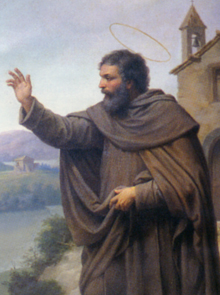Characters
Where am I? The famous people of Palena » St. Falco
St. Falco
Saint



Belonging to the noble family of Poerio, Falco withdrew quite early to the monastic life at the convent of Santa Maria of Pesaca in Taverna, where a community of Basilian monks lived, led by the abbot Ilarione. Following the looting and ravages ??by the Saracens around 980 Falco and six other brothers, led by the abbot Ilarione, set off for a safer place in which to spend their ascetic life. So they landed in the valley of the Aventine in Abruzzo, and settled at the rock of Prata, between Casoli and Civitella Messer Raimondo. There they founded a small monastery where they lived according to a rule of strict austerity, feeding on grasses and praying.
After the death of Nicola Geco Ilarione, among the six remaining, Falco became the abbot of the small community who went on a pilgrimage to Rome, close to the Lake Fucino they cured seven who had been possessed.
On the death of abbot Nicola the small community split up and each monk went his own way, each saint is linked to an area in Abruzzo, San Rinaldo to Fallascoso, San Franco to Francavilla, Saint Stephen the wolf was buried at the monastery of the Holy Spirit in Maiella, St. John gave his name to Rocca San Giovanni and the remains of San Nicola Greco were took to Guardiagrele. The history of San Falco was linked to the community of Palena. On the death of Nicola, Falco decided to go to Rome. Towards the end of the day he reached Palena and tried to cross the ford of Mount Coccia but he had no strength left and decided to stop. Quickly word spread in the town of the presence of this monk and that upon his arrival many evil spirits disappeared. Falco never went away from that mountain, he lived in a small hermitage enjoying the respect and devotion of the entire palenese community. It was here that he died in an unspecified year of the eleventh century. His remains were transported to the church of S. Egidio, where they remained, buried, until they were moved to the church dedicated to him and St. Antonio Martyr in 1383, many were the miracles which were accomplished before the mortal remains of the saint.
They came out unscathed from the violent earthquake that shook Palena. Following the third reconstruction of the building the skull of San Falco was placed in the reliquary bust of Domenico Capozzi, while the rest of the remains were placed inside two caskets exposed for devotion by the faithful.


Belonging to the noble family of Poerio, Falco withdrew quite early to the monastic life at the convent of Santa Maria of Pesaca in Taverna, where a community of Basilian monks lived, led by the abbot Ilarione. Following the looting and ravages ??by the Saracens around 980 Falco and six other brothers, led by the abbot Ilarione, set off for a safer place in which to spend their ascetic life. So they landed in the valley of the Aventine in Abruzzo, and settled at the rock of Prata, between Casoli and Civitella Messer Raimondo. There they founded a small monastery where they lived according to a rule of strict austerity, feeding on grasses and praying.
After the death of Nicola Geco Ilarione, among the six remaining, Falco became the abbot of the small community who went on a pilgrimage to Rome, close to the Lake Fucino they cured seven who had been possessed.
On the death of abbot Nicola the small community split up and each monk went his own way, each saint is linked to an area in Abruzzo, San Rinaldo to Fallascoso, San Franco to Francavilla, Saint Stephen the wolf was buried at the monastery of the Holy Spirit in Maiella, St. John gave his name to Rocca San Giovanni and the remains of San Nicola Greco were took to Guardiagrele. The history of San Falco was linked to the community of Palena. On the death of Nicola, Falco decided to go to Rome. Towards the end of the day he reached Palena and tried to cross the ford of Mount Coccia but he had no strength left and decided to stop. Quickly word spread in the town of the presence of this monk and that upon his arrival many evil spirits disappeared. Falco never went away from that mountain, he lived in a small hermitage enjoying the respect and devotion of the entire palenese community. It was here that he died in an unspecified year of the eleventh century. His remains were transported to the church of S. Egidio, where they remained, buried, until they were moved to the church dedicated to him and St. Antonio Martyr in 1383, many were the miracles which were accomplished before the mortal remains of the saint.
They came out unscathed from the violent earthquake that shook Palena. Following the third reconstruction of the building the skull of San Falco was placed in the reliquary bust of Domenico Capozzi, while the rest of the remains were placed inside two caskets exposed for devotion by the faithful.




